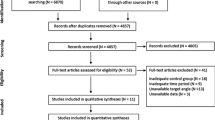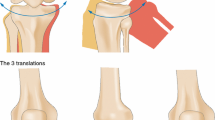Abstract
Background
Knee stiffness after total knee arthroplasty (TKA) often leads to pain and discomfort, failing to meet patients’ expectations on the surgical procedure. Despite the growing debate on the topic, a comprehensive literature analysis of stiffness causes has never been conducted. Thus, the purpose of the present study was to systematically review the literature regarding the main causes of stiffness after TKA.
Methods
Pubmed Central, Scopus, and EMBASE databases were systematically reviewed according to the Preferred Reporting Items for Systematic Reviews and Meta-analysis (PRISMA) guidelines for studies on stiffness and pain or discomfort after TKA through November 2020. Overall, 25 articles matched the selection criteria and were included in the study. Clinical relevance and strength of evidence of the included studies were graded using the risk of bias and the methodological index for non-randomized studies quality assessment tools.
Results
The main causes of pain and discomfort due to stiffness were surgery-related issues, i.e., component malpositioning and over-voluming, implant loosening, psychological distress, and obesity, which could be considered “modifiable” factors, and expression of profibrotic markers, high material hypersensitivity-related cytokines level, male gender, previous contralateral TKA, and high pre-operative pain, which could be considered “non-modifiable” factors.
Conclusion
The use of alternative technologies such as surgical robots, anatomy-based devices, and more inert and less stiff component materials could help in reducing stiffness caused by both modifiable and even some non-modifiable factors. Furthermore, early diagnostic detection of stiffness onset could consistently support surgeons in patient-specific decision-making.

Similar content being viewed by others
Data availability
Not applicable.
Abbreviations
- MRI:
-
Magnetic resonance images
- KSS:
-
Knee Society Score
- PCS:
-
Pain Catastrophizing Scale Score
- OKS:
-
Oxford Knee Score
- FP:
-
Infrapatellar fat pad
- SM:
-
Synovial membrane
- WOMAC:
-
Western Ontario and McMaster Universities Osteoarthritis Index
- QWB-7:
-
Quality of Well-Being scale
- SF:
-
Short Form 12 scores
- KOOS:
-
The Knee injury and Osteoarthritis Outcome Score
- ER:
-
External rotation
- IR:
-
Internal rotation
- NR:
-
Normal rotation
References
Evans JT, Walker RW, Evans JP, Blom AW, Sayers A, Whitehouse MR (2019) How long does a knee replacement last? A systematic review and meta-analysis of case series and national registry reports with more than 15 years of follow-up. Lancet 393:655–663
Tekin B, Unver B, Karatosun V (2012) Expectations in patients with total knee arthroplasty. Acta Orthop Traumatol Turc 46:174–180
Clement ND, Bardgett M, Weir D, Holland J, Gerrand C, Deehan DJ (2018) Three groups of dissatisfied patients exist after total knee arthroplasty: early, persistent, and late. Bone Joint J 100-B:161–169
Hirschmann MT, Amsler F, Rasch H (2015) Clinical value of SPECT/CT in the painful total knee arthroplasty (TKA): a prospective study in a consecutive series of 100 TKA. Eur J Nucl Med Mol Imaging 42:1869–1882
Hirschmann MT, Konala P, Iranpour F, Kerner A, Rasch H, Friederich NF (2011) Clinical value of SPECT/CT for evaluation of patients with painful knees after total knee arthroplasty—a new dimension of diagnostics? BMC Musculoskelet Disord 12:36
Cheuy VA, Foran JRH, Paxton RJ, Bade MJ, Zeni JA, Stevens-Lapsley JE (2017) Arthrofibrosis associated with total knee arthroplasty. J Arthroplast 32:2604–2611
Donaldson JR, Tudor F, Gollish J (2016) Revision surgery for the stiff total knee arthroplasty. Bone Joint J 98-B:622–627
Sanders TL, Kremers HM, Bryan AJ, Kremers WK, Stuart MJ, Krych AJ (2017) Procedural intervention for arthrofibrosis after ACL reconstruction: trends over two decades. Knee Surg Sports Traumatol Arthrosc 25:532–537
Rodríguez-Merchán EC (2019) The stiff total knee arthroplasty: causes, treatment modalities and results. EFORT Open Rev 4:602–610
Moher D, Liberati A, Tetzlaff J, Altman DG, PRISMA Group (2009) Preferred reporting items for systematic reviews and meta-analyses: the PRISMA statement. J Clin Epidemiol 62:1006–1012
Abdelnasser MK, Adi MM, Elnaggar AA, Tarabichi S (2020) Internal rotation of the tibial component in total knee arthroplasty can lead to extension deficit. Knee Surg Sports Traumatol Arthrosc 28:2948–2952
Bédard M, Vince KG, Redfern J, Collen SR (2011) Internal rotation of the tibial component is frequent in stiff total knee arthroplasty. Clin Orthop Relat Res 469:2346–2355
Planckaert C, Larose G, Ranger P, Lacelle M, Fuentes A, Hagemeister N (2018) Total knee arthroplasty with unexplained pain: new insights from kinematics. Arch Orthop Trauma Surg 138:553–561
Scott CEH, Clement ND, Yapp LZ, MacDonald DJ, Patton JT, Burnett R (2019) Association between femoral component sagittal positioning and anterior knee pain in total knee arthroplasty: a 10-year case-control follow-up study of a cruciate-retaining single-radius design. J Bone Joint Surg Am 101:1575–1585
White PB, Ranawat AS (2016) Patient-specific total knees demonstrate a higher manipulation rate compared to “off-the-shelf implants.”. J Arthroplast 31:107–111
Marmor S, Renault E, Valluy J, Saffarini M (2019) Over-voluming predicted by pre-operative planning in 24% of total knee arthroplasty. Knee Surg Sports Traumatol Arthrosc 27:1544–1551
Gu A, Malahias M-A, Cohen JS, Richardson SS, Stake S, Blevins JL, Sculco PK (2020) Prior knee arthroscopy is associated with increased risk of revision after total knee arthroplasty. J Arthroplast 35:100–104
Hagman DS, Granade CM, Smith LS, Yakkanti MR, Malkani AL (2020) Results of cemented posterior-stabilized total knee arthroplasty in obese patients with an average 10-year follow-up. J Arthroplast 35:2097–2100
Sadoghi P, Leithner A, Weber P, Friesenbichler J, Gruber G, Kastner N, Pohlmann K, Jansson V, Wegener B (2011) Radiolucent lines in low-contact-stress mobile-bearing total knee arthroplasty: a blinded and matched case control study. BMC Musculoskelet Disord 12:142
Mann CJ, Bradley AM, Jones ER, McNamara IR, Smith TO, Riley GP (2019) Stiffness post-total knee replacement: a proof of principle study investigating the effect of gene expression analysis of markers of fibrosis. Knee 26:914–922
Graves CM, Otero JE, Gao Y, Goetz DD, Willenborg MD, Callaghan JJ (2014) Patient reported allergies are a risk factor for poor outcomes in total hip and knee arthroplasty. J Arthroplast 29:147–149
Paish HL, Baldock TE, Gillespie CS, Del Carpio PA, Mann DA, Deehan DJ, Borthwick LA, Kalson NS (2019) Chronic, active inflammation in patients with failed total knee replacements undergoing revision surgery. J Orthop Res 37:2316–2324
Yang S, Dipane M, Lu CH, Schmalzried TP, McPherson EJ (2019) Lymphocyte transformation testing (LTT) in cases of pain following total knee arthroplasty: little relationship to histopathologic findings and revision outcomes. J Bone Joint Surg Am 101:257–264
Belford K, Gallagher N, Dempster M, Wolfenden M, Hill J, Blaney J, O’Brien S, Smit A-M, Botha P, Molloy D, Beverland D (2020) Psychosocial predictors of outcomes up to one year following total knee arthroplasty. Knee 27:1028–1034
Lavernia CJ, Villa JM, Iacobelli DA (2015) What is the role of mental health in primary total knee arthroplasty? Clin Orthop Relat Res 473:159–163
Razmjou H, Boljanovic D, Wright S, Murnaghan J, Holtby R (2015) Association between neuropathic pain and reported disability after total knee arthroplasty. Physiother Can 67:311–318
Clement ND, Bardgett M, Weir D, Holland J, Deehan DJ (2019) Increased symptoms of stiffness 1 year after total knee arthroplasty are associated with a worse functional outcome and lower rate of patient satisfaction. Knee Surg Sports Traumatol Arthrosc 27:1196–1203
Clement ND, Merrie KL, Weir DJ, Holland JP, Deehan DJ (2019) Asynchronous bilateral total knee arthroplasty: predictors of the functional outcome and patient satisfaction for the second knee replacement. J Arthroplast 34:2950–2956
Gungor S, Fields K, Aiyer R, Valle AGD, Su EP (2019) Incidence and risk factors for development of persistent postsurgical pain following total knee arthroplasty: a retrospective cohort study. Medicine (Baltimore) 98:e16450
Järvenpää J, Kettunen J, Soininvaara T, Miettinen H, Kröger H (2012) Obesity has a negative impact on clinical outcome after total knee arthroplasty. Scand J Surg 101:198–203
Liebensteiner M, Wurm A, Gamper D, Oberaigner W, Dammerer D, Krismer M (2019) Patient satisfaction after total knee arthroplasty is better in patients with pre-operative complete joint space collapse. Int Orthop 43:1841–1847
Liebs TR, Herzberg W, Roth-Kroeger AM, Rüther W, Hassenpflug J (2011) Women recover faster than men after standard knee arthroplasty. Clin Orthop Relat Res 469:2855–2865
Parvizi J, Nunley RM, Berend KR, Lombardi AV, Ruh EL, Clohisy JC, Hamilton WG, Della Valle CJ, Barrack RL (2014) High level of residual symptoms in young patients after total knee arthroplasty. Clin Orthop Relat Res 472:133–137
Putman S, Argenson J-N, Bonnevialle P, Ehlinger M, Vie P, Leclercq S, Bizot P, Lustig S, Parratte S, Ramdane N, Colmar M, Société française de chirurgie orthopédique et traumatologie (SOFCOT) (2018) Ten-year survival and complications of total knee arthroplasty for osteoarthritis secondary to trauma or surgery: A French multicentre study of 263 patients. Orthop Traumatol Surg Res 104:161–164
Gong S, Xu W, Wang R, Wang Z, Wang B, Han L, Chen G (2019) Patient-specific instrumentation improved axial alignment of the femoral component, operative time and perioperative blood loss after total knee arthroplasty. Knee Surg Sports Traumatol Arthrosc 27:1083–1095
Nakahara I, Takao M, Bandoh S, Bertollo N, Walsh WR, Sugano N (2012) Novel surface modifications of carbon fiber-reinforced polyetheretherketone hip stem in an ovine model. Artif Organs 36:62–70
Slim K, Nini E, Forestier D, Kwiatkowski F, Panis Y, Chipponi J (2003) Methodological index for non-randomized studies (minors): development and validation of a new instrument. ANZ J Surg 73:712–716
Ditton E, Johnson S, Hodyl N, Flynn T, Pollack M, Ribbons K, Walker FR, Nilsson M (2020) Improving patient outcomes following total knee arthroplasty: identifying rehabilitation pathways based on modifiable psychological risk and resilience factors. Front Psychol 11:1061
Funding
This research was supported by Invibio Knees Limited: Resolution n.194 of June 12th 2020.
Author information
Authors and Affiliations
Contributions
S.Z and L.B conceived of the presented idea and were in charge of overall direction and planning; S.DP, A.M, D.A, and N.P wrote the manuscript with input from all authors; R.Z and G.B did the bibliographical research and drew up tables and figure.
Corresponding author
Ethics declarations
Ethics approval
Not applicable.
Consent to participate
Not applicable.
Consent for publication
Not applicable.
Conflict of interest
The authors declare no competing interests.
Additional information
Publisher’s note
Springer Nature remains neutral with regard to jurisdictional claims in published maps and institutional affiliations.
Appendix
Appendix
Rights and permissions
About this article
Cite this article
Zaffagnini, S., Di Paolo, S., Meena, A. et al. Causes of stiffness after total knee arthroplasty: a systematic review. International Orthopaedics (SICOT) 45, 1983–1999 (2021). https://doi.org/10.1007/s00264-021-05023-3
Received:
Accepted:
Published:
Issue Date:
DOI: https://doi.org/10.1007/s00264-021-05023-3




